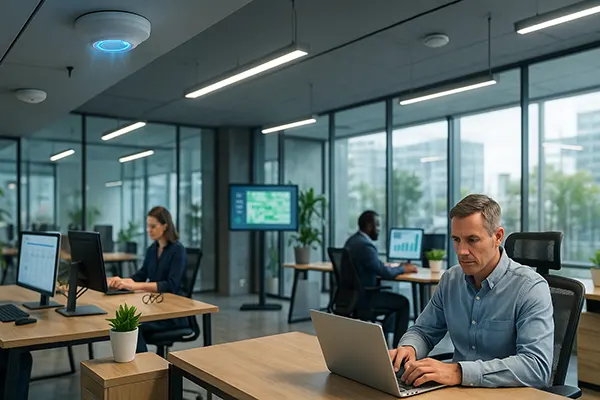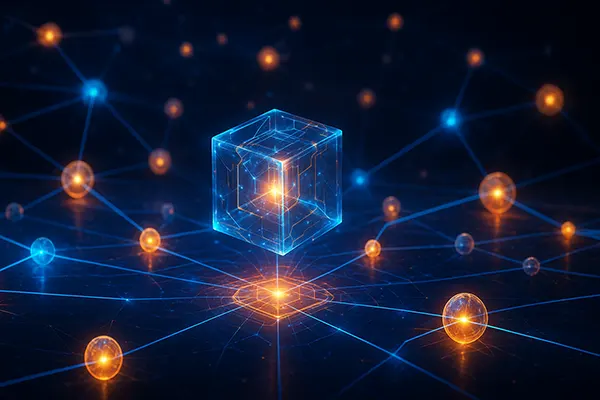Smart Offices: How Software and IoT Are Transforming the Workplace

In 2025, workplaces are undergoing a digital transformation driven by smart office software and the Internet of Things (IoT). The modern office is no longer just a physical space—it’s an intelligent environment that adapts to the needs of employees, increases productivity, and reduces operational costs. Businesses are investing in smart technologies to create flexible, efficient, and sustainable workspaces that respond in real time to human behaviour and environmental changes.
What Defines a Smart Office
A smart office combines interconnected technologies—software, sensors, and automation systems—that work together to improve employee comfort and organisational efficiency. These systems collect data about occupancy, energy consumption, and environmental conditions, helping companies make data-driven decisions. Smart lighting and climate control, for example, adjust automatically based on the number of people in a room, reducing waste and creating optimal working conditions.
Automation plays a crucial role in maintaining a consistent and productive environment. Through integrated software, managers can control temperature, lighting, and even meeting room availability from a single dashboard. This level of control reduces downtime and creates an atmosphere where employees can focus on meaningful tasks rather than logistical issues.
Security and safety are also key components of a smart office ecosystem. IoT-based systems monitor access points, detect movement, and alert security teams to potential risks. Combining software analytics with real-time IoT data helps prevent unauthorised entry and ensures a safe workplace for all.
Core Technologies and Components
The foundation of a smart office relies on IoT sensors that gather and transmit data to central software systems. Motion sensors detect occupancy, temperature sensors maintain a stable climate, and smart locks enhance access control. These devices communicate through cloud-based platforms that process information and execute automatic adjustments across the building.
Another vital element is the integration of artificial intelligence and machine learning. These technologies analyse patterns of usage and suggest optimisations. For example, AI-driven energy management systems can forecast when a building will be most occupied and adjust energy consumption accordingly. This predictive capability leads to long-term cost savings and greater environmental sustainability.
In addition, mobile applications allow employees to interact directly with the office environment. From booking meeting rooms to personalising desk lighting, workers gain greater autonomy, which enhances satisfaction and productivity.
Real-World Applications of Smart Office Software
One of the most widespread applications of smart office technology is energy efficiency. Buildings equipped with IoT devices and automation software can significantly reduce electricity and heating costs by adjusting consumption dynamically. According to 2025 data, companies using advanced automation solutions report an average of 25–30% lower utility expenses compared to conventional offices.
Workplace management software is another major area of development. Platforms such as Siemens Enlighted, Honeywell Forge, and Spacewell enable businesses to monitor space utilisation and manage desk-sharing systems in hybrid offices. These tools provide insights that help redesign layouts to suit evolving work patterns.
Smart offices also contribute to employee well-being. Systems that regulate air quality, temperature, and lighting improve concentration and reduce fatigue. As a result, companies adopting IoT-based office solutions report higher levels of satisfaction and engagement among staff.
Examples of IoT and Software in Practice
In London, major corporations have adopted IoT systems that automatically adjust environmental settings based on employee presence. For instance, Unilever’s headquarters employs over 30,000 connected devices that communicate through a central management platform, reducing carbon emissions by 40% since 2020.
Similarly, Microsoft’s Amsterdam office uses smart meeting systems that integrate with calendars and sensors to book rooms automatically when employees arrive. This eliminates scheduling conflicts and optimises room usage throughout the day.
Emerging solutions like Cisco Smart Building and Schneider Electric EcoStruxure focus on complete automation, combining building management with real-time analytics. These systems provide detailed insights into energy flow, allowing organisations to meet their sustainability goals while maintaining comfort and efficiency.

Challenges and Considerations in Implementing Smart Offices
Despite the growing benefits, smart office technology presents several challenges. Privacy concerns are at the forefront, as IoT sensors continuously collect data about movement, temperature preferences, and space usage. Organisations must ensure compliance with data protection regulations such as GDPR and establish transparent policies regarding how information is stored and processed.
Integration is another significant challenge. Many companies use multiple, unconnected systems, which can lead to inefficiencies or conflicts between software solutions. The future of smart offices depends on developing universal protocols and APIs that allow seamless communication between devices and platforms.
Finally, cost remains a barrier for smaller businesses. Although IoT devices have become more affordable, large-scale implementation—especially across multiple locations—requires considerable investment in infrastructure, cybersecurity, and staff training.
The Future of Smart Workspaces
Looking ahead, experts predict that by 2030 most corporate buildings will integrate smart technologies by default. Offices will use data-driven insights to predict maintenance needs, manage hybrid work models, and optimise sustainability. Edge computing and 5G networks will enhance the speed and reliability of IoT communications, making real-time automation even more responsive.
Employees will increasingly expect personalised environments that adapt to their preferences. From climate settings to desk positioning, every element will respond dynamically through intelligent systems. This shift marks a transition from standardised workplaces to human-centred ecosystems.
Ultimately, the concept of a smart office goes beyond technology—it reflects a cultural change in how businesses perceive productivity, sustainability, and employee well-being. The collaboration between IoT, AI, and software engineering is redefining the future of work in ways unimaginable just a decade ago.



